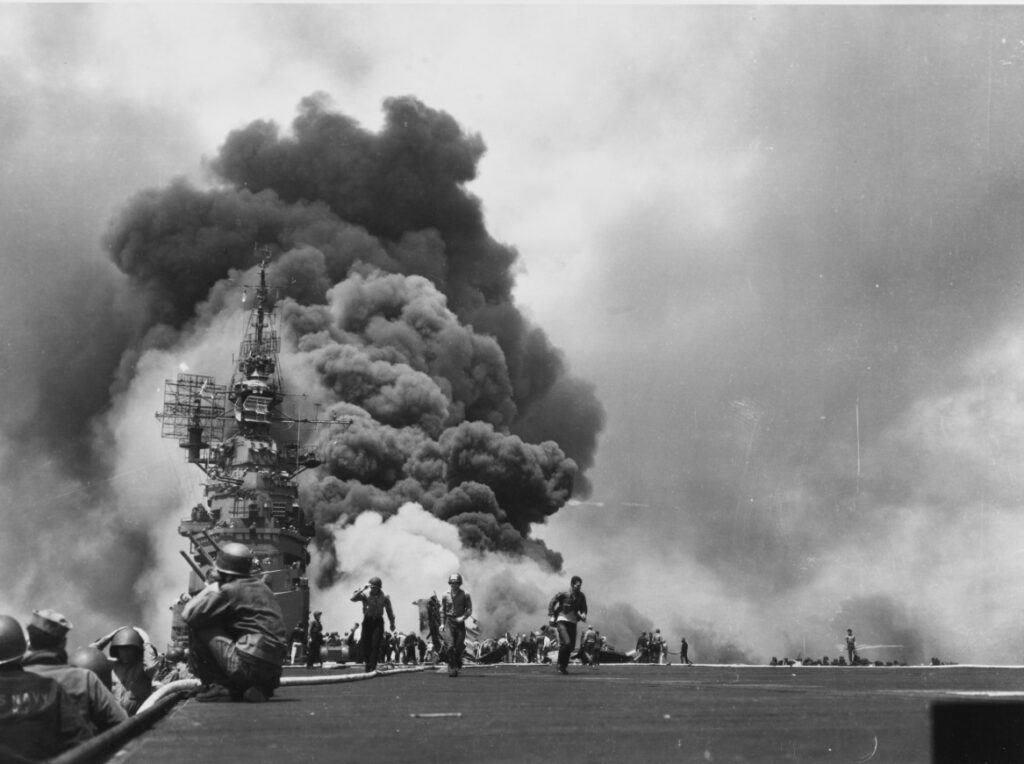“Information on and Means for Combating Suicide Plane Attacks”

Last week, while rummaging around the National Archives digital catalog, I found a report dated 14 April 1945 from Admiral Raymond Kelly Turner, then Commander Amphibious Forces, U.S. Pacific Fleet. Titled “Information on and Means for Combating Suicide Plane Attacks,” the Admiral sent it to Cominch (Admiral Ernest King), the various Navy bureaus, and other senior commands, including the ships directly under Turner’s command.
The “means for combating suicide planes…” mentioned in the report appear to be those created by Admiral John McCain and his staff, with input from Admiral “Jocko” Clark, in late 1944.1
These means included increasing the number of fighters onboard carriers (which enabled them to increase the number and complexity of Combat Air Patrols). They also established picket ships 60 miles away to provide earlier warning of approaching enemy attacks. Finally, they prevented Japanese aircraft from taking off by continually having one of three waves of fighters over enemy airfields during daylight hours.
Advantages of A Suicide Plane Attack
The report’s introduction stated:
The Principal differences between suicide plane attacks by the Japanese on a large scale and conventional airplane attacks are as follows:
(a) The range of the enemy attack is greater because no return trip is necessary.
(b) Percentage of hits is higher because the missile is aimable right up to the point of contact.
(c) Suicide pilots are more determined and daring and are not deterred by actual or psychological obstacles.
(d) The suicide plane with or without a bomb is an extremely effective incendiary agent because of the gasoline carried.2

Five Things I Learned About The Navy’s Response
- From 1 October to 15 December 1944, one US Navy CVE was sunk, 6 CVEs, 3 CVs (including Franklin), and 2 CVLs were damaged by suicide planes (twelve total). “Other means” (enemy gunfire, torpedo, bombs) accounted for 1 CVL, 1 CVE sunk, and 1 CVE damaged. (In his book, The Fast Carriers: The Forging of an Air Navy, Clark G. Reynolds writes that Admiral Takijiro Onishi, Commander of the 1st Air Fleet, believed it would take eight bombers with an escort of 16 fighters to sink one carrier where one to three Kamikazes could accomplish the same mission.3
- Of the three tactics mentioned above, the report stated that “destruction of enemy aircraft on the ground is the most effective method of preventing enemy suicide plane attacks.”4
- Identification Friend or Foe (IFF) was a radio signal sent out by each Allied aircraft to identify itself to Allied ships. The report emphasizes that “Friendly aircraft must be indoctrinated to return to their own dispositions with IFF on.”5 This may have been because destroyer captains in DESRON 21 asked “Headquarters” to insist that US aircraft use IFF at all times as it was difficult to distinguish friend from foe. It was “shoot first and ask questions later.”6
- The report highlighted the role of lookouts due to radar’s limitations.
(a) “The lookout must realize his importance. He must be inoculated with the desire to do a good job.
(b) Lookouts should receive daily recognition training.
(c) Lookouts must be required to confine their attention to assigned sectors, even during attacks; not neglecting the astern sector, and not to indulge in sight-seeing or day-dreaming.”7
5. Readers familiar with the Asian-Pacific War understand the advantage that Variable Time (VT) fuses gave anti-aircraft defenses. Time after time, various authors mentioned how important they were. In an October 2020 article in Naval History Magazine, historian Trent Hone stated that “It was undoubtedly the best weapon against suicide attacks.”8 Until I read this report, I did not know that “Their weakness is their arming distance (800 yards minimum) and difficulty of getting the 5″ gun aimed at the target and loaded quickly enough. Training should be aimed at reducing this time and increasing local control effectiveness.”9 Note that suicide planes first appeared in late October 1944. The original report was published in early February 1945, meaning accuracy of the 5″ guns was still an issue then. VT shells were an asset, but the authors believed that crews could be faster and engage the approaching aircraft earlier.
This report interested me because it is a primary source stating that “destruction of enemy aircraft on the ground was their best weapon against suicide planes.” That indirectly explains why Task Force 58 was off the coast of Japan in March 1945. Franklin was also involved during the October 1944 Battle of Leyte Gulf and was one of the CVs referred to in the statistics. It also helps me to understand the Navy’s actions during 1944-45 and may assist me in putting my book’s readers in the big picture.
Did you arrive here via a search engine? I am the author of the forthcoming book Heroes By The Hundreds: The Story of the USS Franklin (CV-13). In addition to writing about the bravery of the crews that saved her, I will discuss the lessons we can learn in leadership and decision-making and the changes the US Navy made because of those lessons.
Feel free to follow me on Facebook. There, I am [M. Glenn Ross, Author](https://www.facebook.com/MGlennRoss/). I also write a monthly newsletter, **Glenn’s After-Action Report**, about subjects I find interesting in my research. You can sign up for it below. Feel free to leave a comment or ask a question. Thanks for reading.
-Glenn
Footnotes
- Clark G. Reynolds, The Fast Carriers The Forging of an Air Navy, (Annapolis: Naval Institute Press, 2013) 290
- Suicide Plane Attacks – Information on Means for Combating. (RS-1014 dated 14 April 1945, 1
- Reynolds, 331
- Suicide Plane Attacks, 3
- Suicide Plane Attacks, 4
- John F. Wukovits, Tin Can Titans: The Heroic Men and Ships of World War II’s Most Decorated Navy Destroyer Squadron (Boston: Da Capo Press, 2017)188
- Suicide Plane Attacks, 5
- Trent Hone, Countering The Kamikaze, Naval History Magazine, October 2020
- Suicide Plane Attacks, 6